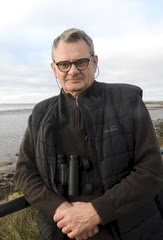Had she been alive today, the conflict in Lebanon would have caused heartbreak to one British ornithologist in particular - Vere Benson. Best known as the author of the phenomenally successful The Observer’s Book of Birds, Ms Benson lived happily for a few years in Beirut and was also the author and illustrator of Birds of Lebanon and The Jordan Area which was published in 1970 in both Arabic and English versions. The extract below is from a Kindle e-book on the life of Vere Benson - The 'Invisible' Ornithologist
Birds of Lebanon and The Jordan Area is the product of extensive research about a part of the world whose birdlife was (and is) known to few ornithologists in the western world.
It also contains her own impressive artwork, with eight richly colourful plates, each of which depicts several species.
The frontpiece reveals that the distributors were Frederick Warne & Co, the company behind the Observer series but the publishers were the International Council for Bird Preservation (now known as BirdLife International).
Far from receiving an advance fee and royalties from the sale of the book, Benson herself part-financed its publication along with the National Audubon Society in the USA.
It is thought proceeds of the book, which was also published in an Arabic edition, were donated to the Lebanese League for Bird Preservation which had been established in 1967.
Reflecting the high esteem in which she was held, the list of acknowledgements is long, most of them highly regarded male ornithologists such as P.A.D. Hollom, James Ferguson-Lees and Peter Hayman.
As a woman in the male-dominated world of ornithology, Benson was always uncomfortably aware of commonplace perceptions that her female perspective might be coloured by unscientific 'robin-stroking' sentimentality.
In the preface of early editions of The Observer's Book of Birds, she makes a point of denying that she might be 'soft-centred' : "I hope no one will think I am a mere sentimentalist as regards birds.
"On the contrary, the keynote of all my work on the text of this book has been accuracy."
The fact that museums and academic institutions are also included in the list of acknowledgements further emphasises that whatever perceptions some have held on the basis of Benson's involvement with the Bird-Lovers League, she was now recognised as no lightweight but a serious and ornithologist.
Not that she had forfeited the human touch. She also includes a charming note of gratitude to a particular individual who may not have been a birder but whose support had been precious: "I am much obliged to Mr Karnig Chahinian of Beirut, to whom many thanks for the loan of his little car in 1964."
In Birds of Lebanon and The Jordan Area, Benson is the first writer to record the spectacular southerly migration of eagles and other raptors down the Lebanon coast in autumn.
"This wonderful sight has to be seen to be believed," she writes of her experience in 1963."When I first saw it after sunrise, I could scarcely believe the evidence of my eyes as about 400 eagles passed over within 45 minutes."
In later years, she experienced the same spectacle, describing it in more detail.
"Suddenly out of the sky, about 80 or 100 little hawks appeared like a cloud of mosquitoes.
"They looked very small in comparison with the eagles and were almost certainly Levant Ssparrowhawks which are known to flock like this.
"Almost as suddenly as they had appeared, they seem to find an up- current of air and go up like a swirl of dust to an altitude at which they disappeared."
She continues "It will be found well worthwhile to lie on one's back with a telescope or binoculars during the migrations and see what a wealth of species and numbers are on the move."
Elsewhere in this superb book, there are detailed illustrations and descriptions of certain species, for instance the Rhodopechys finch, about which very little had been known at the time.
As in her earlier books, Benson again sounds a loud note of alarm on the loss of birds as a result of the activities of man, urging conservation initiatives to arrest the decline.
She writes: "Amongst the breeding birds which are in danger of extinction are the resident and summering owls and birds of prey, while the smaller birds, the larks and buntings, wheatears and Nightingales, are so persecuted by shooters that they have a much lower breeding success than they should have.
"Colourful birds such as Bee-eaters and the equally beautiful Rollers are slaughtered unremittingly.
"The shy and rare Persian Robin is also unlikely to succeed, and three kinds of kingfisher are in little better state."
She continues: "As for the waders and wetland birds, with so little habitat in which to shelter, they are picked off almost at once. The Kentish and Little Ringed Plovers, for instance, stand little chance of survival for breeding."
As in some edition of The Observer's Book of Birds, Benson goes on to emphasise "an urgent need is for the strictest control of toxic chemicals, particularly insecticides".
She writes: "The way it is used in Lebanon is not only destructive to birds, insects and some mammals, but already seems to be a menace to the people, especially those who appear to be spraying in the fields with little or no protection for themselves."
Benson was born in Bromley, Kent but moved at a young age with her parents and sister to Cornwall, later, as an adult, living variously in Norfolk, Cumbria, Devon, Beirut and Middlesex.
She died, aged 78, in 1987.
 |
| Nightjars, Bee-eaters and a Roller - a spread from Birds of Lebanon |
 |
| A page from the manuscript of the Arabic edition |
THE 'INVISIBLE' ORNITHOLOGIST: VERE BENSON - AUTHOR OF THE OBSERVER'S BOOK OF BRITISH BIRDS eBook : Wright, James: Amazon.co.uk: Kindle Store






.jpg)





































